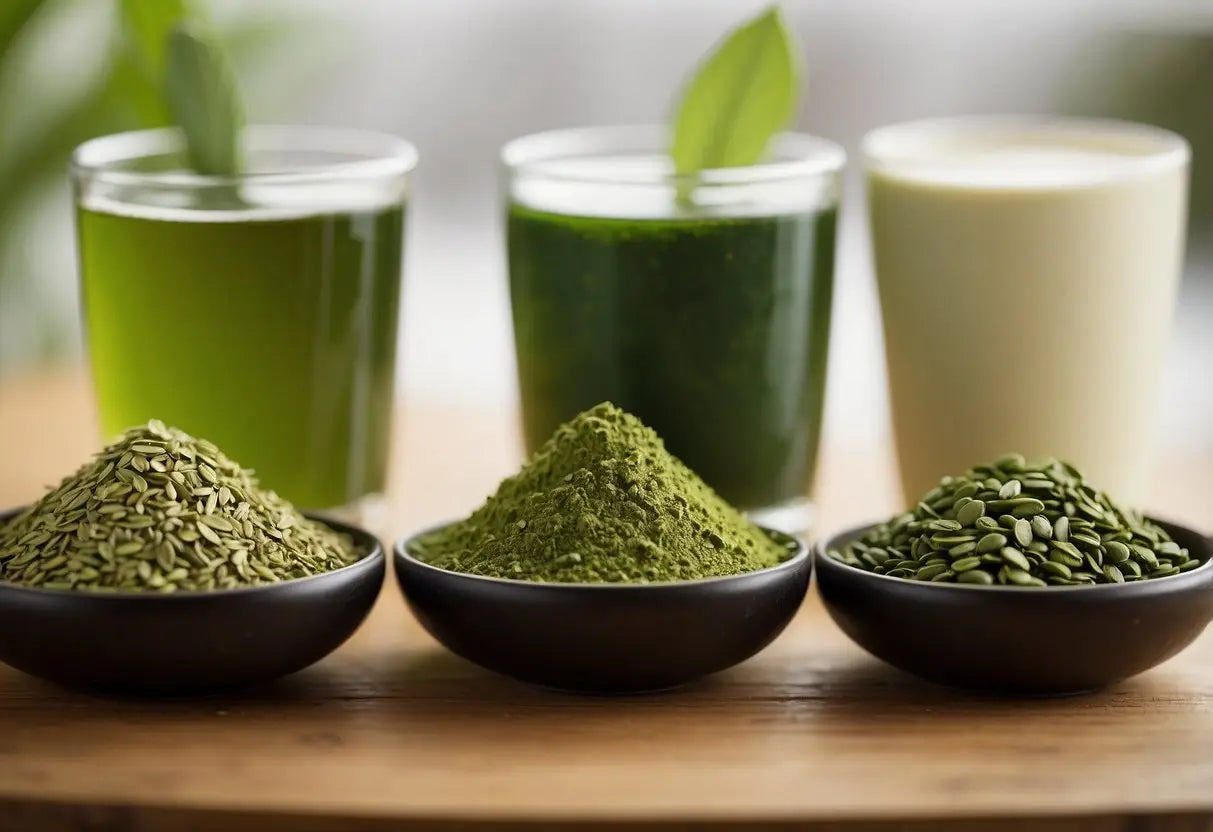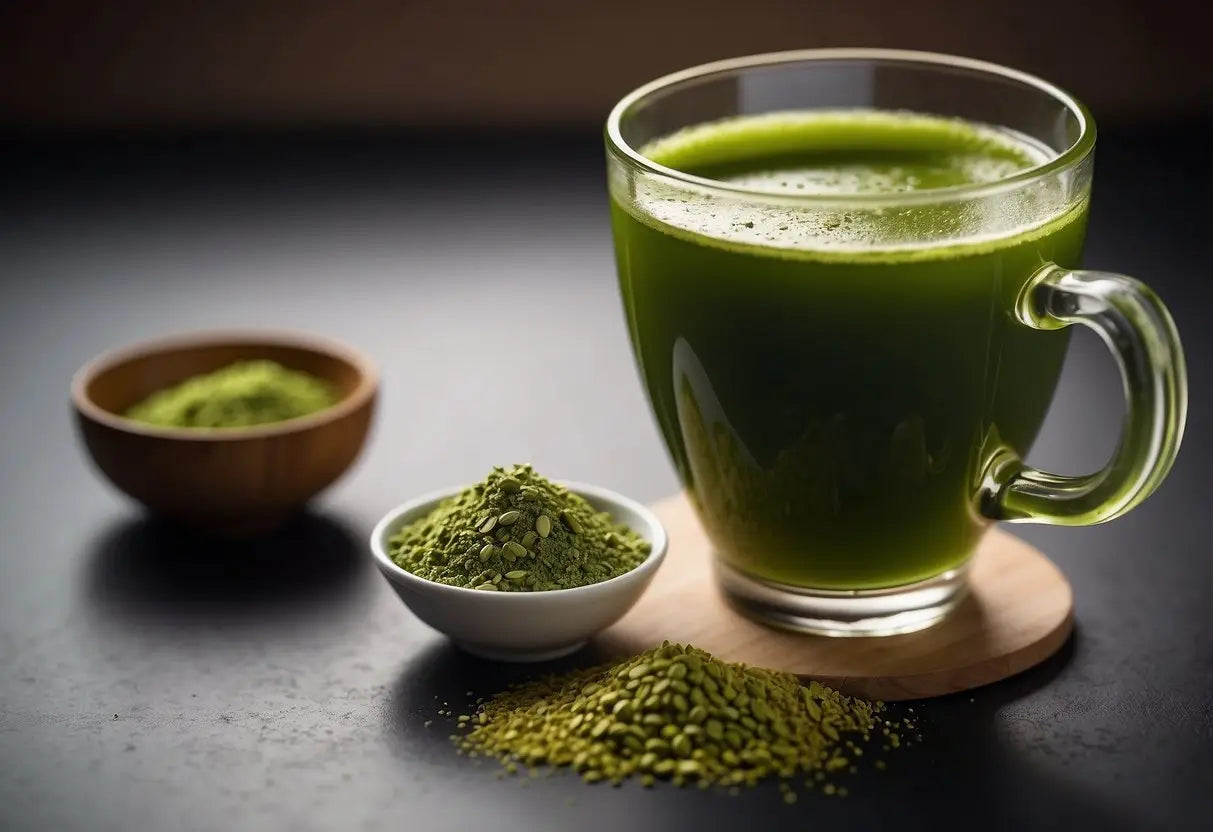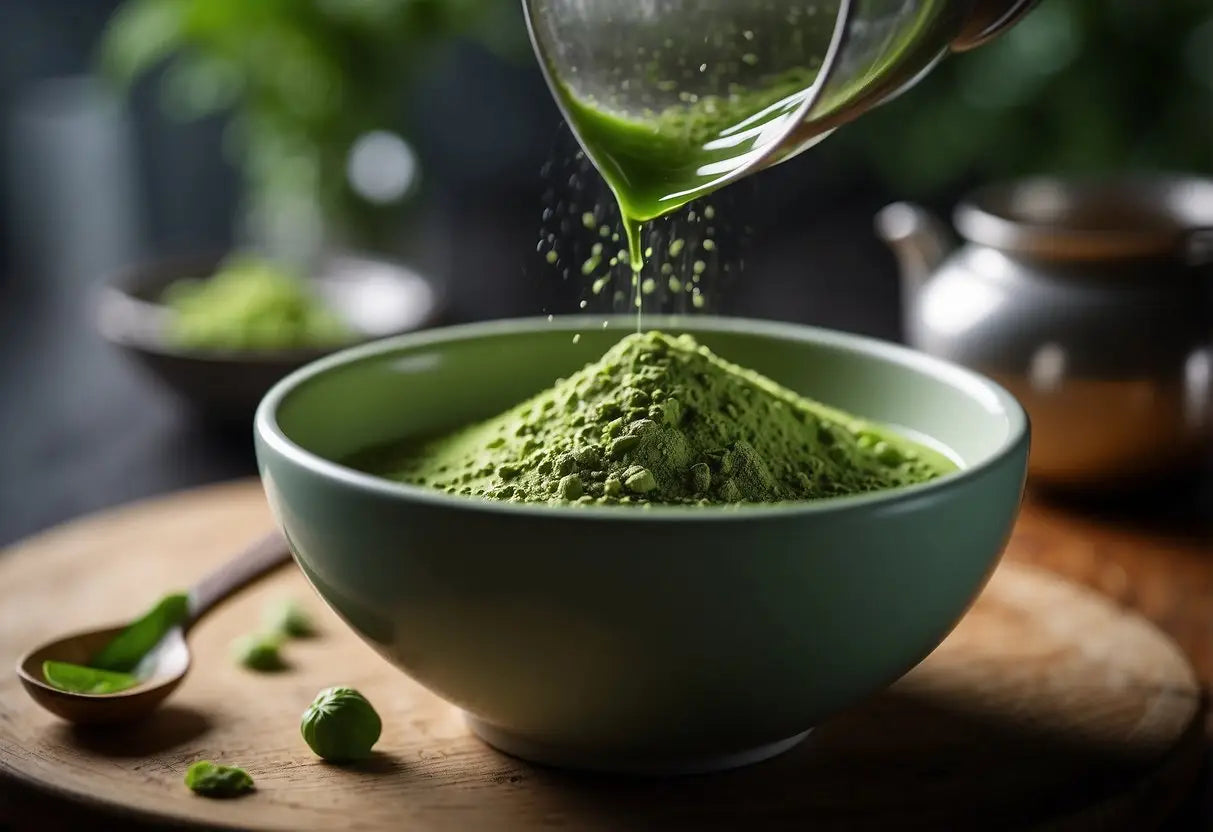Difference Between Matcha and Green Tea
Green tea is made from the leaves of the Camellia sinensis plant. The leaves are quickly heated by pan-firing or steaming. This process preserves the green color and fresh flavor. The origin of green tea can be traced back to China, where it has been consumed for thousands of years.
Matcha:
Bestsellers
Matcha is a type of green tea, but it is unique in its production and consumption. For matcha, the tea plants are shade-grown for about three weeks before harvest. This method increases chlorophyll levels, giving the leaves a vibrant green color. The leaves are then stone-ground into a fine powder.
Key Differences:
| Aspect | Green Tea | Matcha |
|---|---|---|
| Processing | Steamed or pan-fired | Shade-grown, then stone-ground |
| Consumption | Steeped in water | Whisked into water, consuming the powder |
| Flavor | Fresh, slightly vegetal | Rich, creamy, umami |
Green tea is typically brewed using whole leaves, and the resulting tea is a light, yellowish-green liquid.
In contrast, matcha involves whisking the powder directly into hot water, creating a thick, frothy beverage.
You may notice that matcha has a richer, more intense flavor compared to regular green tea. This is due to the higher concentration of nutrients and antioxidants in the powdered form.
Processing Methods
The processing methods for matcha and green tea differ significantly. These differences affect their flavor, nutrient content, and traditional uses.
Cultivation
For matcha, tea bushes are shaded for about three weeks before harvest. This increases chlorophyll production and amino acid content, giving matcha its vibrant green color and rich flavor.
Green tea is grown in full sun. This results in a lighter color and more astringent taste compared to matcha. The full sun exposure affects the chemical composition, making it less rich in amino acids.
Harvesting
Matcha leaves are hand-picked with great precision, selecting only the youngest, most tender leaves. This careful selection ensures a high-quality product.
Green tea leaves are often machine-harvested, which can result in a wider variety of leaf maturity. This method is less labor-intensive but may include slightly older leaves.
Grinding
Matcha leaves are steamed, dried, and then ground into a fine powder using granite stone mills. This slow grinding process can take an hour to produce just 30 grams of matcha. The careful grinding preserves nutrients and achieves a fine texture.
Green tea leaves are usually rolled and dried, not ground into a powder. The leaves are either pan-fried or steamed, then rolled to preserve their shape and dried to lock in flavors.
Lao Ban Zhang
By focusing on these key aspects, you gain a clearer picture of how matcha and green tea differ not just in taste but also in methods of production.
Physical Characteristics

When comparing matcha and green tea, their physical characteristics such as color and texture differ significantly, impacting their preparation and appearance.
Color
Matcha is known for its vibrant green hue. This bright green color results from the shading process used during cultivation, which increases chlorophyll levels. The higher quality the matcha, the richer and more intense the color.
Green tea leaves range in color from yellow-green to dark green. The shades can vary based on the type of green tea and its processing. Unlike matcha, green tea does not undergo a shading process, resulting in a less intense color.
Texture
Matcha has a fine, silky powder texture. This is due to the leaves being stone-ground into a powder. The fine texture allows it to be easily whisked into water, creating a smooth mixture.
Green tea leaves are typically whole or slightly broken. The texture can range from wiry and flat to tightly rolled balls, depending on the variety and processing method. Unlike matcha, these leaves are steeped in water and then removed.
Flavor Profiles

Matcha has a unique, rich flavor that is often described as umami. The taste can be quite intense, with a sweet, vegetal undertone. A slight astringency might be present, adding complexity to its profile. The texture is smooth and creamy, especially when prepared traditionally.
Green tea, on the other hand, has a lighter, more delicate taste. The flavor can vary from sweet to slightly bitter, depending on the type and preparation. You might notice a grassy or floral note, which is generally more subtle compared to matcha. The mouthfeel is usually less creamy and more watery.
Here’s a quick comparison:
| Matcha | Green Tea | |
|---|---|---|
| Flavor | Rich, umami, vegetal | Light, sweet, grassy |
| Texture | Smooth, creamy | Watery, delicate |
| Astringency | Slightly present | Mild or none |
In addition, the aroma of matcha tends to be stronger and more earthy. In contrast, green tea offers a fresher and lighter scent.
Using matcha in culinary products like lattes, desserts, or smoothies enhances its creamy texture and bold taste. Green tea is often enjoyed plain or with mild flavorings, providing a refreshing and subtle beverage experience.
Nutritional Content

Matcha and green tea both offer unique nutritional benefits.
Matcha is a powdered tea. You consume the entire leaf, which means you get more nutrients. Matcha is rich in antioxidants, particularly EGCG, which is known for its health benefits. It also contains fiber, chlorophyll, and vitamins such as A, C, and E.
Green tea leaves are typically steeped in water, so you consume only the extracted components. Green tea also contains antioxidants but in lower concentrations than matcha. It provides vitamins like C and B2, as well as minerals like manganese and fluorine.
Consider the following table comparing their nutritional content:
| Nutrient | Green Tea (per cup) | Matcha (per cup) |
|---|---|---|
| Antioxidants | Moderate | Very High |
| Caffeine | 20-50 mg | 60-70 mg |
| L-Theanine | Low | High |
| Vitamin C | 6 mg | 1-2 mg |
| Fiber | None | 1-2 grams |
Antioxidants in matcha are significantly higher due to the consumption of whole leaves.
Caffeine levels are also higher in matcha, providing a more pronounced energy boost compared to green tea.
L-Theanine, an amino acid that promotes relaxation without drowsiness, is found in higher concentrations in matcha.
Fiber content in matcha offers additional digestive benefits, whereas green tea contains no fiber.
Understanding these differences can help you choose the right tea for your dietary needs.
Health Benefits

Both matcha and green tea offer numerous health benefits due to their high content of antioxidants. These antioxidants help reduce oxidative stress in your body.
Matcha contains higher levels of catechins, particularly EGCG, which may aid in promoting heart health and supporting weight loss. Matcha is also rich in L-theanine, an amino acid that can improve relaxation and focus.
Green tea also provides a good amount of antioxidants. Drinking green tea regularly can help improve your metabolic rate, which may contribute to weight loss. It may also support cardiovascular health by reducing bad cholesterol levels.
Here’s a quick comparison:
| Benefit | Matcha | Green Tea |
|---|---|---|
| Antioxidants | Higher concentration | Moderate concentration |
| L-theanine | Higher amount | Lower amount |
| Catechins (EGCG) | Higher concentration | Moderate concentration |
You might find that matcha provides a more concentrated dose of nutrients because you consume the entire tea leaf.
Green tea, on the other hand, still offers significant benefits while typically being easier to prepare and less expensive.
Preparation and Consumption

Matcha and green tea differ significantly in their methods of preparation and consumption. Understanding these differences can enhance your appreciation and experience of both beverages.
Traditional Preparation
Matcha is prepared using a ceremonial method that highlights its cultural significance. You start by sifting the matcha powder into a bowl to prevent clumps. Then, add hot water, typically around 175°F (80°C). Using a bamboo whisk (chasen), you whisk the matcha in a rapid zigzag motion until a frothy layer forms on the surface. The resulting drink is a vibrant green liquid with a rich, umami flavor.
Green tea, on the other hand, involves brewing whole leaves. Heat water to about 175-185°F (80-85°C) and pour it over the green tea leaves, which are usually placed in a teapot or infuser. Steep the tea for 2-3 minutes. The brewed tea is then poured into a cup, offering a lighter, more refreshing taste compared to matcha.
Modern Preparation
Modern methods of preparing matcha often cater to convenience and versatility. You might see matcha lattes, where matcha powder is mixed with steamed milk, or even matcha smoothies. These beverages often use blenders or frothers to achieve a smooth consistency. Matcha can also be incorporated into various recipes, like desserts and baked goods, expanding its use beyond traditional tea ceremonies.
Green tea, in contemporary contexts, is often prepared using tea bags for ease and speed. Simply steep a green tea bag in hot water for a few minutes. Ready-to-drink green tea bottles are also popular, providing a quick and hassle-free option. Additionally, green tea is commonly used in flavored drinks, like iced teas and sparkling beverages, appealing to diverse taste preferences.
Popular Uses and Cultural Significance
Matcha and green tea enjoy a rich history and significance in various cultures.
Matcha
-
Tea Ceremonies: In Japan, matcha is a key element of traditional tea ceremonies, symbolizing peace and mindfulness.
-
Culinary Uses: Matcha is also used in cooking and baking, adding flavor and color to dishes like mochi, ice cream, and lattes.
-
Health Benefits: Often consumed for its potential health benefits, including antioxidants and vitamins.
Green Tea
-
Everyday Beverage: Commonly drunk as an everyday beverage in many East Asian countries, enjoyed for its refreshing taste.
-
Cultural Practices: Green tea is often featured in cultural practices such as Chinese tea ceremonies and Korean tea etiquette.
-
Medicinal Uses: Historically, green tea has been used for its medicinal properties, believed to aid digestion and improve well-being.
Both matcha and green tea hold special places in their respective cultures, each with unique applications and traditions.
Price and Accessibility
When comparing matcha and green tea, price is an important factor. Matcha tends to be more expensive than regular green tea due to its labor-intensive production process.
| Type | Average Price Per Ounce |
|---|---|
| Matcha | $10 - $20 |
| Green Tea | $3 - $10 |
The difference in price is due to how matcha is grown, harvested, and processed. The shade-growing technique and stone grinding contribute to its higher cost.
Accessibility varies. Green tea is widely available in grocery stores, online shops, and tea specialty stores. You can find it in various forms such as loose leaves, tea bags, and bottled beverages.
Matcha is less commonly found in regular grocery stores but is available in specialty tea shops and online. It is often sold in smaller quantities and packaged in airtight containers to maintain freshness.
You can also explore local or online retailers for different grades of matcha. Ceremonial grade is typically the most expensive and used for traditional tea ceremonies. Culinary grade is cheaper and used for cooking and baking.
Environmental Impact
Matcha and green tea both originate from the Camellia sinensis plant. The environmental impact of cultivating each differs due to their distinct production processes.
Matcha requires shaded growth for several weeks before harvest. This shading increases chlorophyll content but also demands more resources. Extra shading structures and maintenance elevate the carbon footprint.
Green tea generally requires less intensive cultivation methods. The standard sunlight growth reduces the need for additional materials, lowering its environmental impact compared to matcha.
Water usage varies between the two. Matcha farming often consumes more water due to the need for maintaining high humidity. Green tea farms, depending on the region and method, might use less water.
Energy consumption is also a factor. Matcha production involves grinding the leaves into powder, which uses more energy. Green tea processing, though still energy-dependent, typically involves simpler drying techniques.
When considering pesticide and fertilizer usage, both types can be grown organically or conventionally. Organic methods reduce the environmental impact but may have lower yields, requiring more land.
Transportation emissions depend on your location and the distance the products travel. Importing matcha or green tea from different parts of the world can significantly increase their carbon footprints.
Packaging impacts both. Matcha often comes in smaller, airtight containers to preserve freshness, potentially leading to more packaging waste. Bulk buying of green tea can mitigate some of these effects.
← Older post Newer post →











